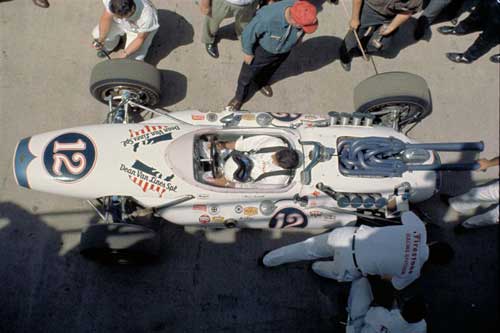FUMES
 Monday, April 27, 2009 at 10:35AM
Monday, April 27, 2009 at 10:35AM April 29, 2009
"NASCAR just puts us in this box, and we'll race like this until we kill somebody." - Carl Edwards
By Peter M. De Lorenzo
(Posted 4/27, 10:00AM) Detroit. There is no form of racing I despise more than "restrictor-plate" racing. As a matter of fact, calling it racing is totally inappropriate and inaccurate. Instead, it's the most crazy and egregious form of "racertainment" as perpetrated by NASCAR, one that cheats serious injury and death each and every time it's staged. The end of last Sunday's race at Talladega could have easily resulted in a tragedy that would have swallowed the sport of racing whole. If Carl Edwards' car had not been contained by the catch fencing and went careening into the stands, we would have a modern day repeat of the disaster at the 24 Hours of Le Mans in 1955 on our hands, only potentially much worse in terms of loss of life and in terms of the massive outcry from the media-saturated world we live in. Needless to say, the aftermath would have been cataclysmic for motorsport around the globe and would have paralyzed the sport.
For historical perspective, when 84 people were killed and over 100 injured after Pierre Levegh's Mercedes-Benz SLR went into the main grandstand along the pit straight at Le Mans on that dark day, the global outcry after that horrific event almost killed racing - as it was, it adversely affected motorsport for years afterwards.
Carl Edwards is right of course, because it is NASCAR's "M.O." to be proactive when it comes to creating ingenious new ways to extricate cash from sponsors, TV networks and its paying fans, while being totally reactive when it comes to incorporating modern safety techniques and improving the actual racing itself. In 1987, when Bobby Allison's car went into the catch fencing at Talladega - tearing down almost 100 yards of it and injuring spectators with flying shrapnel - NASCAR immediately mandated smaller carburetors for the rest of the year at Talladega and Daytona, while instituting restrictor-plates for the following season at those two "big' tracks.
When Dale Earnhardt was killed at the Daytona 500 in 2001, NASCAR immediately set about to develop its "Car of Tomorrow" even though the warnings were there for years that NASCAR had lagged in incorporating modern safety technologies in their race cars.
The problem in all of this is that NASCAR never gets out in front of any of these crucial decisions, it's always being forced to act after the fact, or after a set of circumstances presents itself that is simply too intolerable to allow to continue, let alone contemplate.
Once again NASCAR is at a crossroads when it comes to its on-track product. Besides all of the other negatives associated with NASCAR these days - the declining TV numbers, the declining fan base, the economic impact of the implosion of two of three of the Detroit manufacturers, the negative national economic conditions, etc. - NASCAR not only has to totally reassess the kinds of cars it puts on the race track, it has to consider revamping the tracks themselves.
One scenario brought forth by several observers is to knock down the Talladega banking, go to a flatter race track, pull the restrictor plates off (allowing the drivers to have control again) and reduce the recipe for disaster in one fell swoop. I agree with that, however, I would recommend fundamentally changing the cars too. I want to see small displacement V8s (2.0 - 2.4-liters) incorporating more modern technologies and cars more closely adhering to their production specifications. The fact that NASCAR continues to strive to remove the linkage between production cars and their race cars is a looming issue, and one more the powers that be in Daytona Beach need to get in front of. (Making the Sprint Cup a "pony car" series utilizing Camaro, Challenger and Mustang and requiring mostly production specs would go a long way toward getting that done.)
Nate Ryan, writing in USA Today, provided two more interesting quotes from the near debacle at Talladega. The first was from driver Marcus Ambrose, who said, "This is crazy racing. We can legitimize it all we want, but it's insanity on four wheels."
It's clear that "restrictor-plate" racing has run its course. It is extraordinarily dangerous and a monumentally stupid endeavor, and if it continues it's only a matter of when - not if - that a tragedy of epic proportion and consequences unfolds.
Where does NASCAR stand in all of this? Here's the second quote provided by Nate Ryan from the weekend, this one from vice president of corporate communications, Jim Hunter, who said NASCAR would analyze Edwards' crash "to see if there's anything we can do."
To see if there's anything we can do?
Simply outrageous, inconceivable and unconscionable.
And I'll add one more word for it: unforgivable.
NASCAR is playing Russian Roulette with its drivers, its fans and the sport of racing itself.
And I think it's high time for the enthusiasts of this sport to make their feelings known to Brian France and Co. in no uncertain terms, before it's too late.
See another live episode of "Autoline After Hours" hosted by Autoline Detroit's John McElroy, with Peter De Lorenzo and auto industry PR veteran Jason Vines this Thursday evening, April 30, at 7:00PM EDT at www.autolinedetroit.tv.
By the way, if you'd like to subscribe to the Autoline After Hours podcasts, click on the following links:
Subscribe via iTunes: http://itunes.apple.com/WebObjects/MZStore.woa/wa/viewPodcast?id=311421319
Subscribe via RSS:
Publisher's Note: As part of our continuing series celebrating the "Glory Days" of racing, we're proud to present another noteworthy image from the Ford Racing Archives. - PMD
 (Courtesy of the Ford Racing Archives)
(Courtesy of the Ford Racing Archives)
Indianapolis, Indiana, 1965. A bird's eye view of one of the all-time greats - Mario Andretti - sitting in his Brawner Hawk-Ford "Dean Van Lines Special" at the Indianapolis Motor Speedway. Andretti was first entered in the Indy 500 that year and finished third, claiming the race's Rookie of the Year award. Andretti then went on to win the Champ Car series championship that year, becoming the youngest national champion in series history at the age 25. Andretti would repeat taking the title in 1966, 1969 and 1984. He also, of course, won his only Indianapolis 500 in 1969 and remains one of only two Americans to win the Formula 1 World Championship, among his many achievements in motor racing.




